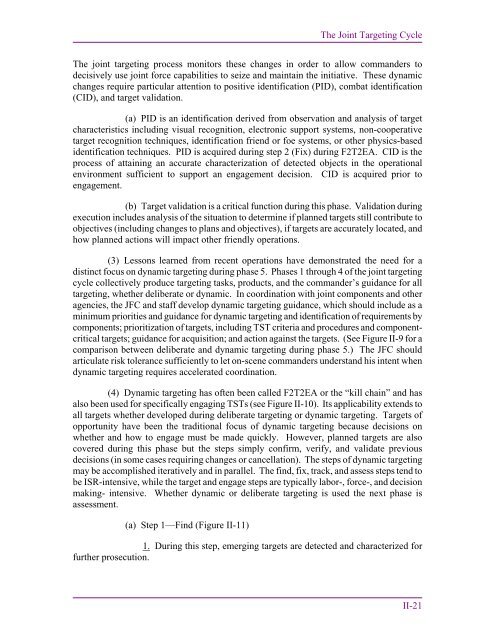Joint Targeting
1F87id9
1F87id9
You also want an ePaper? Increase the reach of your titles
YUMPU automatically turns print PDFs into web optimized ePapers that Google loves.
The <strong>Joint</strong> <strong>Targeting</strong> Cycle<br />
The joint targeting process monitors these changes in order to allow commanders to<br />
decisively use joint force capabilities to seize and maintain the initiative. These dynamic<br />
changes require particular attention to positive identification (PID), combat identification<br />
(CID), and target validation.<br />
(a) PID is an identification derived from observation and analysis of target<br />
characteristics including visual recognition, electronic support systems, non-cooperative<br />
target recognition techniques, identification friend or foe systems, or other physics-based<br />
identification techniques. PID is acquired during step 2 (Fix) during F2T2EA. CID is the<br />
process of attaining an accurate characterization of detected objects in the operational<br />
environment sufficient to support an engagement decision. CID is acquired prior to<br />
engagement.<br />
(b) Target validation is a critical function during this phase. Validation during<br />
execution includes analysis of the situation to determine if planned targets still contribute to<br />
objectives (including changes to plans and objectives), if targets are accurately located, and<br />
how planned actions will impact other friendly operations.<br />
(3) Lessons learned from recent operations have demonstrated the need for a<br />
distinct focus on dynamic targeting during phase 5. Phases 1 through 4 of the joint targeting<br />
cycle collectively produce targeting tasks, products, and the commander’s guidance for all<br />
targeting, whether deliberate or dynamic. In coordination with joint components and other<br />
agencies, the JFC and staff develop dynamic targeting guidance, which should include as a<br />
minimum priorities and guidance for dynamic targeting and identification of requirements by<br />
components; prioritization of targets, including TST criteria and procedures and componentcritical<br />
targets; guidance for acquisition; and action against the targets. (See Figure II-9 for a<br />
comparison between deliberate and dynamic targeting during phase 5.) The JFC should<br />
articulate risk tolerance sufficiently to let on-scene commanders understand his intent when<br />
dynamic targeting requires accelerated coordination.<br />
(4) Dynamic targeting has often been called F2T2EA or the “kill chain” and has<br />
also been used for specifically engaging TSTs (see Figure II-10). Its applicability extends to<br />
all targets whether developed during deliberate targeting or dynamic targeting. Targets of<br />
opportunity have been the traditional focus of dynamic targeting because decisions on<br />
whether and how to engage must be made quickly. However, planned targets are also<br />
covered during this phase but the steps simply confirm, verify, and validate previous<br />
decisions (in some cases requiring changes or cancellation). The steps of dynamic targeting<br />
may be accomplished iteratively and in parallel. The find, fix, track, and assess steps tend to<br />
be ISR-intensive, while the target and engage steps are typically labor-, force-, and decision<br />
making- intensive. Whether dynamic or deliberate targeting is used the next phase is<br />
assessment.<br />
(a) Step 1—Find (Figure II-11)<br />
1. During this step, emerging targets are detected and characterized for<br />
further prosecution.<br />
II-21


